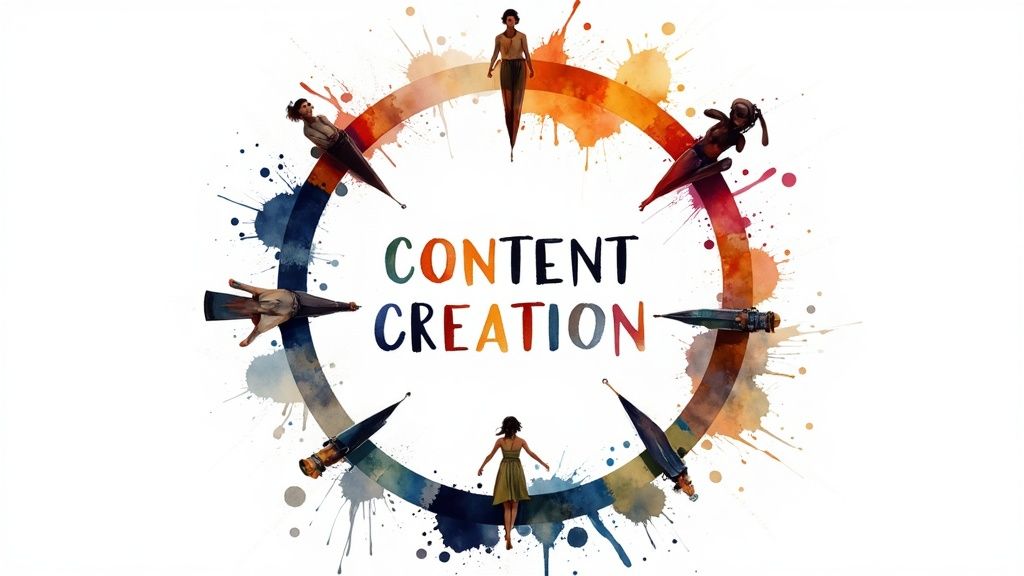The Strategic Power of Content Repurposing

Content creation is an investment that deserves careful planning. Top marketers no longer follow the "one piece, one use" approach. Instead, they multiply their return by transforming their best content into different formats that connect with diverse audiences. It's similar to having a multi-tool - rather than creating separate tools, you adapt one versatile piece to serve multiple purposes.
Why Repurposing Matters
Content repurposing is more than a temporary fix - it's a proven approach that helps businesses reach more people while making the most of their resources. Take a single well-researched blog post - it can become an eye-catching infographic, a set of social posts, a short video clip, or even fuel for a podcast episode. This lets you connect with people who prefer different ways of learning and consuming information.
The numbers show just how effective this approach is. 94% of marketers already make content repurposing a key part of their strategy, with the remaining 6% planning to start soon. Learn more about the latest statistics here: Content Repurposing Statistics for 2023. This widespread adoption shows that single-use content is being replaced by more sustainable methods that deliver better results.
Identifying Repurposing Opportunities
Some content pieces naturally work better for repurposing than others. Finding this high-potential content is crucial for getting the best results. Look at your analytics to spot your top performers - blog posts with steady traffic, videos that spark lots of engagement, or social updates that get people talking. These proven winners make excellent candidates for repurposing into new formats.
Maximizing Evergreen Content
Evergreen content - material that stays relevant over time - is perfect for repurposing. Unlike trending topics that quickly fade, evergreen pieces can be refreshed and reused across different channels, consistently bringing in new audiences while reinforcing your key messages. For more insights, check out Understanding Quality Content: A Strategic Guide. By focusing your repurposing efforts on both high-performing and evergreen content, you'll get the most value from every piece you create.
Unlocking Resource Efficiency Through Smart Repurposing

Content repurposing helps you get more impact from your work without doubling your effort. By thoughtfully adapting existing content into new formats, you can expand your reach while keeping your workload manageable. This approach focuses on making the most of what you've already created.
Identifying High-Potential Content
Start by looking at your best-performing pieces - the content that already connects with your audience. Use analytics to spot which blog posts, videos, and social updates generate the most engagement. This data shows you exactly which topics resonate, so you can focus your repurposing efforts where they'll have the biggest impact. For example, if a blog post about content marketing tips performs well, consider turning those tips into a visual checklist or infographic.
The Power of Evergreen Content
Some content stays relevant year after year, making it perfect for repurposing. Topics like writing basics and fundamental marketing strategies maintain their value over time. You might be interested in: How to create engaging content. When you repurpose this evergreen material across different channels, you reinforce key messages while building your authority in your field. The content keeps working for you long after you first publish it.
Why Repurposing Saves Time and Resources
Content repurposing offers a smart way to create impact without starting from scratch each time. In fact, 48% of marketers choose repurposing because it delivers strong results while saving time. By building on existing material, you can produce more content with less effort and investment. Learn more about content repurposing benefits. This efficiency lets you focus more energy on other important marketing tasks while still maintaining a steady flow of quality content.
Mastering Multi-Format Content Transformation

Creating content for multiple platforms takes more skill than simple copy and paste. The key is adapting your core message to connect with different audiences while keeping your main points intact. Let's explore practical ways to transform your content effectively across various formats.
Understanding Platform-Specific Nuances
Each social platform has its own unique culture and audience preferences. A detailed blog post might work great on your website, but Instagram users might prefer the same information as a eye-catching infographic. Video clips from your latest webinar could make perfect short-form content for TikTok or YouTube. Getting to know these platform differences helps you adapt your content successfully.
Maintaining Message Consistency
Think of content adaptation like telling the same story in different languages - the words change, but the meaning stays the same. Whether someone reads your blog, watches your video, or listens to your podcast, they should walk away with the same key points. This builds trust in your brand and shows your expertise across all platforms.
Practical Workflows for Content Transformation
Here are effective ways to repurpose your content:
- Blog Post to Social Media: Pull out interesting quotes and statistics to create social posts. Add questions to get your followers talking.
- Webinar to Video Series: Break down your webinar recording into bite-sized video clips. Focus each clip on one main point that works well for YouTube or LinkedIn.
- Podcast Episode to Blog Post: Turn your audio into text with transcription, then edit it into an engaging article. This helps more people find and use your content.
- Long-form Content to Infographic: Turn complex information into a clear, shareable visual that catches attention on image-focused platforms.
Examples of Content Transformation
Take a blog post about content repurposing - you could turn it into:
- A simple checklist for social media followers
- A quick video showing one specific technique
- An infographic comparing different content types
- A series of helpful tips shared on Twitter
By getting good at these content transformations, you'll reach more people while working efficiently. This smart approach helps you connect with different audiences and build a stronger content strategy.
Essential Technology Stack for Content Repurposing

The right technology makes all the difference when repurposing content effectively. By carefully selecting tools that work well together, you can create a smooth workflow that helps you get more value from your existing content while maintaining quality.
Key Tools for Efficient Repurposing
Having the right mix of tools can dramatically speed up your content repurposing process while keeping quality high. Here are the essential types of software you'll want to consider:
-
Graphic Design Software: Programs like Canva or Adobe Photoshop help you create eye-catching visuals. Use these to turn blog posts into infographics, social media images, and other visual content.
-
Video Editing Software: For video content, software like Adobe Premiere Pro or Final Cut Pro gives you the tools to edit webinars into short clips and create engaging videos from your existing materials.
-
Audio Editing Software: Tools like Audacity or Adobe Audition are perfect for creating podcasts, audio versions of blog posts, and polishing audio content for different platforms. You might be interested in: 10 best tools for content creation.
-
Transcription Services: Services like Otter.ai or Trint can quickly convert audio and video into text, making it simple to turn podcasts and webinars into written content.
-
AI-Powered Platforms: Platforms like Aeon help automate the process of converting content between formats, which is especially helpful when working at scale.
Building Your Ideal Tech Stack
The best combination of tools depends on your specific needs, budget, and team size. Small businesses might start with free tools, while larger organizations often benefit from investing in more advanced options. Focus on choosing tools that fit naturally into your current workflow and make repurposing easier.
Streamlining Your Workflow with Technology
When you combine these tools effectively, you can create a smooth content repurposing process. For example, after recording a webinar, you might use transcription software to create a blog post, then use design tools to make social media graphics highlighting key points. This approach helps you work efficiently while keeping your message consistent across formats. With practice, you'll find ways to get more value from each piece of content you create.
Measuring and Optimizing Repurposed Content Performance
Once you've invested time creating repurposed content, measuring its performance becomes essential. Like any marketing effort, you need clear data to understand what's working and what needs improvement. Let's explore practical ways to track and optimize your repurposed content strategy.
Setting Clear Goals and KPIs
Start by defining specific goals for your content repurposing efforts. Do you want more website traffic? Higher engagement on social media? More email signups? Each goal needs matching metrics to track progress. For instance, if you're focused on growing brand awareness, track metrics like:
- Social media engagement rates
- Content shares and mentions
- Reach across platforms
- Brand sentiment
Implementing Multi-Touch Attribution
Most customers interact with your content multiple times before converting. Multi-touch attribution helps you understand how different pieces of repurposed content work together along the customer journey. This gives you a complete picture of which content formats and platforms drive the best results at each stage.
Tracking Performance Across Platforms
Use analytics tools to monitor how your repurposed content performs on each platform. Some key metrics to track:
- Website traffic and time on page
- Video views and completion rates
- Social media engagement
- Email click-through rates
- Lead form submissions
This data shows you where your content resonates most with audiences.
Analyzing and Interpreting Data
Looking at raw numbers isn't enough - you need to draw meaningful insights. For example, if your LinkedIn infographics consistently outperform other formats, that suggests visual content works well for your audience there. Use these patterns to guide future content repurposing decisions.
Using Data to Inform Future Repurposing Strategies
Let your performance data guide your content strategy. Pay attention to:
- Which topics generate the most engagement
- What content formats perform best on each platform
- When your audience is most active
- Which repurposing techniques drive the strongest results
Use these insights to focus your efforts on what works.
Demonstrating ROI to Stakeholders
Track and report on the Return on Investment (ROI) of your repurposing efforts. Show stakeholders concrete results like:
- Increased website traffic from repurposed content
- Lead generation metrics
- Sales attributed to repurposed pieces
- Resource savings from repurposing vs creating new content
- Engagement metrics across platforms
Clear ROI data helps secure continued support for your content repurposing strategy.
Building a Scalable Content Repurposing System
Most content teams recognize the value of repurposing but struggle with making it a consistent process. With a solid system in place, you can efficiently transform content while maintaining quality standards. Let's explore practical approaches to build content repurposing into your regular workflow.
Creating a Content Repurposing Workflow
Start by mapping out clear steps for converting content between formats. A typical workflow might begin with recording a webinar, getting it transcribed, editing the transcript into a blog post, and pulling key quotes for social media. Having these steps documented helps your team work consistently and efficiently.
Training Your Team
Your content team needs hands-on experience with different formats and platforms. Just as a chef trains staff on essential kitchen equipment, you'll want to ensure everyone understands how to use key content tools and follow platform-specific best practices. Regular training sessions keep skills sharp and processes running smoothly.
Establishing Quality Control
Quality checks are essential when repurposing content at scale. Set up review stages where editors can verify that repurposed pieces maintain your brand voice and meet quality standards. Think of this as your quality assurance system - catching any issues before content goes live.
Creating Content With Repurposing in Mind
Plan your content with multiple formats in mind from the start. For example, when creating a research report, consider how sections could become blog posts, data points could become infographics, and key findings could fuel social media content. This forward planning makes repurposing much more natural.
Developing Style Guides and Templates
Clear guidelines and ready-to-use templates speed up the repurposing process. Your style guide should outline voice, tone and branding rules, while templates provide consistent structures for different content types. These tools help maintain quality while saving time.
Choosing the Right Tools
Pick tools that complement your workflow and support your most-used content formats. Your toolkit might include design software, video editors, transcription services, and automation platforms. The right tools make repurposing faster and easier, much like having proper equipment in a professional kitchen.
These strategies help transform random repurposing efforts into a smooth, reliable system. With proper processes in place, you'll get more value from each piece of content while keeping your team efficient and focused.
Looking to add video to your content mix? Check out Aeon, a video platform built for publishers that makes it simple to turn your content into engaging videos.